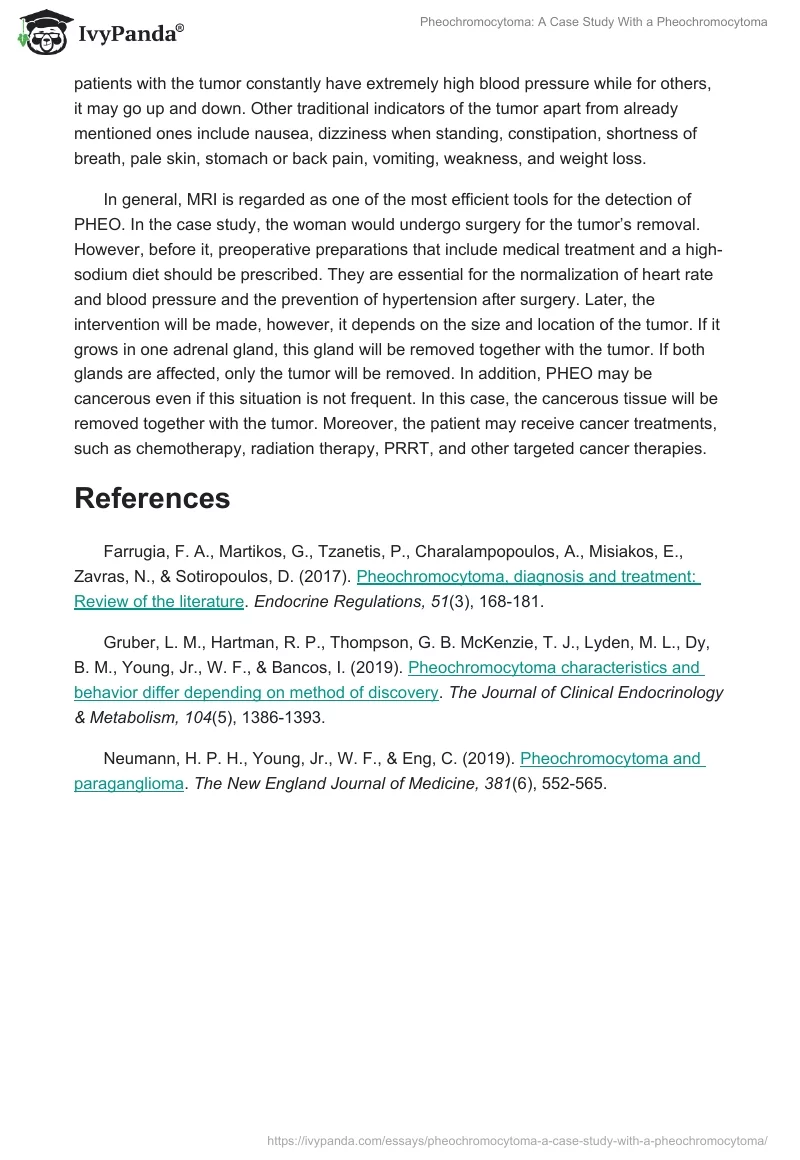The case study addresses a 35-year-old female with hypertension that varies from 180/110 to 120/80 without obvious reasons. As a part of the patient’s examination, MRI was made and it showed a pheochromocytoma (PHEO), also known as an adrenal paraganglioma (Neumann et al., 2019). It is a rare and predominantly noncancerous tumor that occurs and grows in adrenal glands located above the kidneys. Traditionally, PHEO develops in one adrenal gland, however, it may affect both. In fact, this tumor “fascinates and, at times, confounds clinicians” as its symptoms may mimic almost 30 medical disorders (Neumann et al., 2019, p. 552). If left undiagnosed and, therefore, untreated, PHEO may be very dangerous and even lethal – that is why its rapid recognition is important.
The incidence of PHEO ranges is estimated “from 0.005% to 0.1% of the general population and from 0.1% to 0.2% of the adult hypertensive population” (Farrugia et al., 2017, p. 168). Adults, predominantly women, aged 30 to 50 years are vulnerable to the occurrence of this tumor and it is most common in individuals aged 40 to 50 years (Farrugia et al., 2017). In general, adrenal glands produce specific hormones, catecholamines, that regulate metabolism, blood pressure, respiratory and cardiac functions, and blood oxygen transport capacity. In turn, the tumor starts to release hormones as well at higher levels than it should be. The hypersecretion of catecholamines causes diaphoresis, headache, palpitations, irregular hypertension, tremors, episodic anxiety, flash pulmonary edema, and even acute heart failure (Gruber et al., 2019). As a result, the patient’s heart, lungs, brain, and kidneys may be seriously damaged.
As previously mentioned, PHEO is hardly detected as its symptoms may be non-specific. For example, its three classical symptoms – headache, profuse sweating, and palpitations – along with panic attacks and anxiety have become common in the population in the present day. That is why some individuals live with PHEO for many years and do not know about it even if some symptoms are present. Concerning the case study, the woman has hypertension and her blood pressure varied without any reason. Hypertension is one of the symptoms of PHEO that was detected later. Some patients with the tumor constantly have extremely high blood pressure while for others, it may go up and down. Other traditional indicators of the tumor apart from already mentioned ones include nausea, dizziness when standing, constipation, shortness of breath, pale skin, stomach or back pain, vomiting, weakness, and weight loss.
In general, MRI is regarded as one of the most efficient tools for the detection of PHEO. In the case study, the woman would undergo surgery for the tumor’s removal. However, before it, preoperative preparations that include medical treatment and a high-sodium diet should be prescribed. They are essential for the normalization of heart rate and blood pressure and the prevention of hypertension after surgery. Later, the intervention will be made, however, it depends on the size and location of the tumor. If it grows in one adrenal gland, this gland will be removed together with the tumor. If both glands are affected, only the tumor will be removed. In addition, PHEO may be cancerous even if this situation is not frequent. In this case, the cancerous tissue will be removed together with the tumor. Moreover, the patient may receive cancer treatments, such as chemotherapy, radiation therapy, PRRT, and other targeted cancer therapies.
References
Farrugia, F. A., Martikos, G., Tzanetis, P., Charalampopoulos, A., Misiakos, E., Zavras, N., & Sotiropoulos, D. (2017). Pheochromocytoma, diagnosis and treatment: Review of the literature. Endocrine Regulations, 51(3), 168-181.
Gruber, L. M., Hartman, R. P., Thompson, G. B. McKenzie, T. J., Lyden, M. L., Dy, B. M., Young, Jr., W. F., & Bancos, I. (2019). Pheochromocytoma characteristics and behavior differ depending on method of discovery. The Journal of Clinical Endocrinology & Metabolism, 104(5), 1386-1393.
Neumann, H. P. H., Young, Jr., W. F., & Eng, C. (2019). Pheochromocytoma and paraganglioma. The New England Journal of Medicine, 381(6), 552-565.


